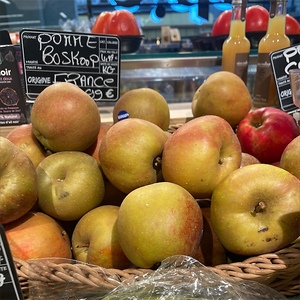


Red Belle de Boskoop Apples
Estimated Inventory, lb : 0
Description/Taste
Belle de Boskoop apples are distinctive looking because they tend to be lumpy and irregular in shape and fairly large in size. Belle de Boskoop Red has a darker red color than the usual variety, which is yellow blushed with red, but otherwise the red sport is the same in every other regard. The texture of this apple’s white-green flesh is juicy, firm, and coarse, with an aromatic and sharp flavor. The beautiful spreading shape of the tree, the large flowers, and disease resistance has made the Belle de Boskoop a popular ornamental option.
Seasons/Availability
Belle de Boskoop Red apples are available in the fall through spring.
Current Facts
The Belle de Boskoop Red apple (botanical name Malus domestica), is a red sport of the normally yellow Belle de Boskoop apple. The original Belle de Boskoop is a heritage apple from the Netherlands. The parentage of this variety is thought to be Rechette de Montfort, though unknown for sure. In the Netherlands, Belle de Boskoop is more often found for sale under the names Schone van Boskoop or Goudreinet.
Nutritional Value
Apples contain a variety of beneficial nutrients important for a healthy diet. One apple contains about a fifth of the daily recommended value of dietary fiber, as well as vitamin C, potassium, and boron. Though Belle de Boskoops have a lower vitamin C content than some other apples, the combined nutrients in this apple help keep the cardiovascular, digestive, and immune systems healthy.
Applications
This variety is useful for both fresh eating out of hand and for cooking and baking. The Belle de Boskoop is a good cooking apple, cooking down into a thick puree that many find does not need any extra sugar. Slice into savory salads, fruit salads, or bake into tarts or pies. The flavor of Belle de Boskoop may be too sharp for some to enjoy as a snacking apple, but can be paired with more mellow cheeses such as gouda or cheddar. This variety may also be used for drying. Belle de Boskoop stores well, and in fact its sharp flavor mellows somewhat and it becomes sweeter as it ages.
Ethnic/Cultural Info
Boskoop, Netherlands—the original birthplace of Belle de Boskoop apple—has been well known for almost a thousand years for its horticultural practices and local plant varieties produced on nurseries. The name of the Belle de Boskoop apple is one of the lasting markers that preserve the horticultural history of the area. The local apple is still one of the most popular Dutch apples and often appears as the main variety used in Dutch apple tarts.
Geography/History
The first Belle de Boskoop apple was grown in the Netherlands in the 1850s near the town of Boskoop, giving the variety its name. Famous nurseryman KJW Ottolander discovered the original Belle de Boskoop on his nursery and originally named the variety Schone de Boskoop. The Belle de Boskoop won the UK’s Royal Horticultural Award almost one-hundred years apart, in 1897 and 1993. The red sport of Belle de Boskoop was developed much later in Denmark in 1950. Today, Belle de Boskoop is most often grown in the Netherlands, Germany, Belgium, Switzerland, and Poland. This variety does not do well in colder climates or areas with dry soil.
Recipe Ideas
Recipes that include Red Belle de Boskoop Apples. One
| Taste of Home |
|
Apple-Gouda Melts |
| The Sunday Baker |
|
Appeltaart: Dutch Apple Pie |
| Simply Recipes |
|
Applesauce |
| Smitten Kitchen |
|
Dutch Apple Pie |
| Diversivore |
|
Swedish Apple Cake with Vanilla Sauce |













